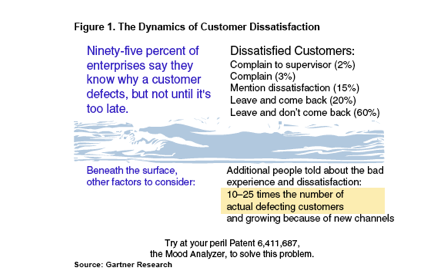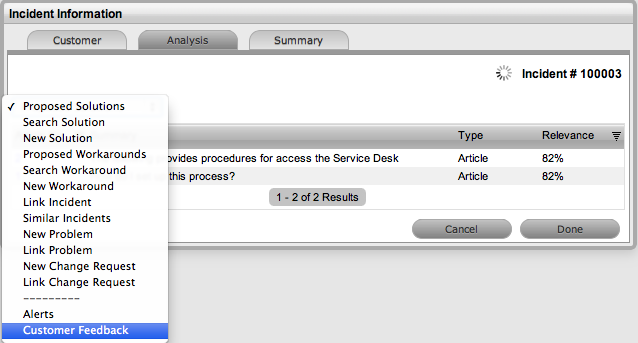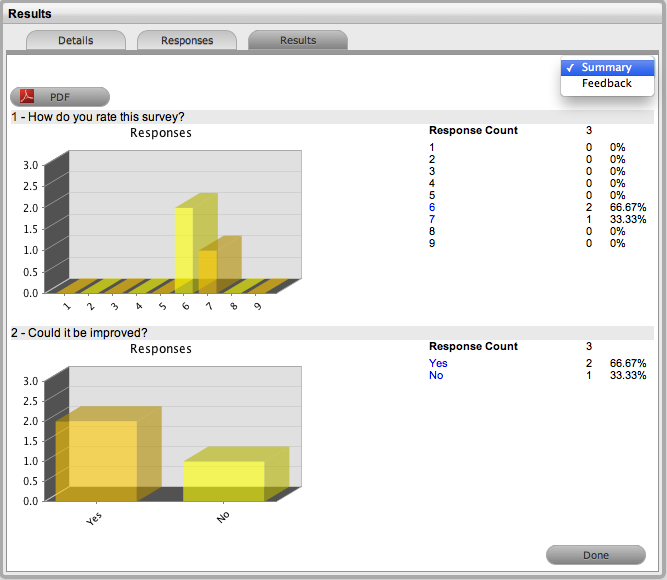
As a support organization that has automated its Service Desk, time has been invested in auditing manual workflow lifecycles and mapping them into the service management system. Consideration has been given to the way support teams work, what are the areas of speciality and by whom they are supported. Service Level Agreements have been agreed on and implemented, hopefully, with contractual obligations being met more often than not. There are very few customer complaints so on the surface of things all is going well, or is it?
System generated statistics capture operational data such as response time and resolution time, which are great for measuring the efficiency of the support service but do not garner the customers sentiment about the support organization (i.e., are they satisfied? Do they have confidence in the support provided?), based on their interaction with the Service Desk.

Service Desk Supervisors who are serious about providing the best possible support and building an environment of continual service improvement must conduct surveys. A variety of surveys should be issued, the results evaluated and action plans adopted relative to the survey response data. To gain a true measure of customer satisfaction with the support service, surveys are a must.
Surveys provide core indicators of satisfaction levels with the service and systems delivered by the Service Desk, and enhance customer satisfaction, support efficiency and cost effectiveness metrics. Measuring end-user satisfaction relative to service desk goals can also assist in determining staff levels and training requirements, budget allocations, outsourcing strategies, IT strategy and rewards for service desk managers and staff.
Good surveys reveal patterns, trends and new information valuable to improving customer service. Three elements that are crucial to successful surveying include:
Asking the right questions
Asking at the right time
Following up feedback.
Even with the first two elements correct, if feedback is ignored, the Service Desk risks alienating its customers and undermining the customer’s confidence in the service.
Gartner Research indicates that 40% of responses are more accurate if customers are surveyed within 24 hours of the service desk interaction. There is also a 10 to 12% increase in response rates with customers who are surveyed immediately after a transaction (Kolsky, 2006). Gartner assessed real-time feedback as ideal and our service management system allows Service Desk operators to survey all customers when a support request is resolved.
The auto-sending of surveys within the system overcomes Gartner’s observed drawbacks of real time surveys being costly and non-scalable.
Building on the trends observed by the point-of-delivery surveys, periodic surveys can be used to gain real sense of the customers’ perceived relationship with the Service Desk. This type of survey tends to be a little more complicated, detailed and specific than a transaction based survey. The questions responses can be rated on a numeric scale of 1 to 5, with a maximum of seven questions being recommended, as longer surveys tend to have lower response rates.
The sample size could be determined by the responses received to the point-of-delivery survey, as these customers have proved to be reliable in completing surveys. However, respondent details and activities must be recorded to ensure that the same customers are not always asked to complete surveys.
Passive surveys can also be used by a Service Desk to provide customers with the opportunity to comment on the service they receive, when the customers feels it is appropriate to do so.
Transaction based and periodic surveys are great for monitoring day-to-day activities and base-lining trends of the Service Desk. To assist with forward planning and service desk evolution, more in depth surveys are required. Planning surveys may not necessarily be automated through Survey option within the system, in fact focus groups or face-to-face surveying methods may be preferred.
With the potential of numerous survey responses being received, no matter how short the list of questions, the Service Desk Manager must set time aside to view the response statistics. In fact it has been found that poorly executed surveys that have no follow-up, promote greater customer dissatisfaction. Should negative feedback be received, the Service Desk Manager must have an appropriate escalation policy to manage the information.
The use of surveys by the Service Desk is a positive demonstration to its customers that it is committed to the service it provides. Operational metrics measure the efficiency of the support service but are not a real indicator of customer satisfaction. To effectively monitor customer sentiment, support technicians’ capability and build a culture of continual improvement surveys are mandatory. To this end a variety of survey techniques should be adopted by Service Desk Supervisors, which include point-of-delivery, periodic, passive and planning surveys.
(Reference: Kolsky, E., 2006, “Implement Customer Satisfaction Management Processes to Improve Revenue”, ID No.:G00134295, 2 March 2006, Page 2. Gartner Research; Kolsky,E. & Maoz, M., 2003 “Using Customer Surveys to Improve Business Processes”. ID No.:SPA-19-1128, 7 February 2003, Page 2. Gartner Research.)
Surveys created within the service management system can be created for serviced Customers, specific Customers, User Role groups, Customers based on Organizational Unit or Item Type ownership, and the General Public. Surveys can be customized to meet the requirements of each audience types. (See: Surveys for detailed information about creation and publication of new Surveys in the service management tool.)
A system Survey Manager can create a point-of-delivery or transaction based survey, within the Knowledge>Survey tab. The Title is completed to reflect the data to be sourced from the customers. The Description that is entered is used to introduce the survey to the Customer when the survey request is emailed to the Customer or accessed on the Customer Portal. From the Audience option, Serviced Customers is selected and the Send on Resolution option is marked to automatically send to the survey to the Customer when their support issue is resolved.
Tip: When constructing point-of-delivery or transaction based surveys it is recommended that the survey be short, that is no more than five questions with yes or no answers. Also, to avoid biased results, all customers should be surveyed regarding the service they received.
Fact: Only one Point of Delivery Survey can be active within the system at any one time.
When a survey is created for Serviced Customers and the Send on Resolution option is not selected, the survey can be sent manually after the Incident is closed. The survey can be emailed from within the Incident Summary screen, by clicking the link that appears when the Incident moves to the status of Closed.
Fact: To ensure Customers do not feel bombarded by the Service Desk, the system will not allow the same survey to be sent to the same customer on multiple occasions. There is also the ability to create Serviced Customers (1in 5) surveys.
The completed Surveys sent to Serviced Customers upon resolution of an Incident, are also accessible within the Analysis tab of the Incident.

Published surveys have the Audience defined as ‘Everyone’ and can be accessed using the Public Surveys link on the system Login page. These ‘surveys to go’ are completed by end-users without logging into the Customer Portal.
To allow Customers complete these Surveys anonymously, ensure the Allow Anonymous option is enabled.
Survey Results are visible under the Summary tab of an Active survey.

Graphical indicators and response percentages are displayed within the Summary filter of the Summary screen. If free text fields are used to obtain Customer comments, they can be accessed in the Feedback filter of the Survey Results Summary tab.
See: Surveys for detailed information about creation and publication of new Surveys in the service management tool.